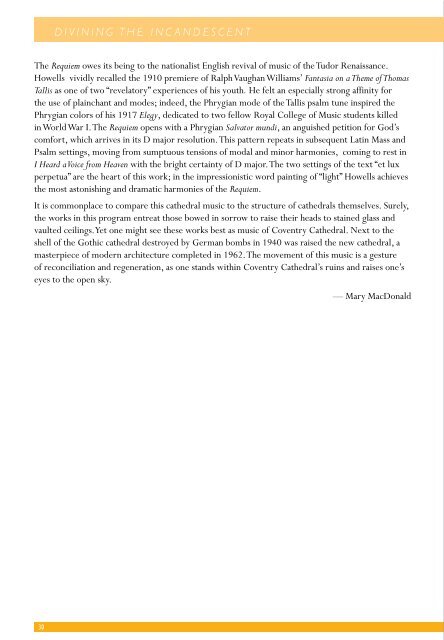Create successful ePaper yourself
Turn your PDF publications into a flip-book with our unique Google optimized e-Paper software.
diViNiNg <strong>the</strong> iNCaNdesCeNt <strong>Program</strong> <str<strong>on</strong>g>Notes</str<strong>on</strong>g><br />
The Requiem owes its being to <strong>the</strong> nati<strong>on</strong>alist English revival of music of <strong>the</strong> Tudor Renaissance.<br />
Howells vividly recalled <strong>the</strong> 1910 premiere of Ralph Vaughan Williams’ Fantasia <strong>on</strong> a Theme of Thomas<br />
Tallis as <strong>on</strong>e of two “revelatory” experiences of his youth. He felt an especially str<strong>on</strong>g affinity for<br />
<strong>the</strong> use of plainchant and modes; indeed, <strong>the</strong> Phrygian mode of <strong>the</strong> Tallis psalm tune inspired <strong>the</strong><br />
Phrygian colors of his 1917 Elegy, dedicated to two fellow Royal College of Music students killed<br />
in World War I. The Requiem opens with a Phrygian Salvator mundi, an anguished petiti<strong>on</strong> for God’s<br />
comfort, which arrives in its D major resoluti<strong>on</strong>. This pattern repeats in subsequent Latin Mass and<br />
Psalm settings, moving from sumptuous tensi<strong>on</strong>s of modal and minor harm<strong>on</strong>ies, coming to rest in<br />
I Heard a Voice from Heaven with <strong>the</strong> bright certainty of D major. The two settings of <strong>the</strong> text “et lux<br />
perpetua” are <strong>the</strong> heart of this work; in <strong>the</strong> impressi<strong>on</strong>istic word painting of “light” Howells achieves<br />
<strong>the</strong> most ast<strong>on</strong>ishing and dramatic harm<strong>on</strong>ies of <strong>the</strong> Requiem.<br />
It is comm<strong>on</strong>place to compare this ca<strong>the</strong>dral music to <strong>the</strong> structure of ca<strong>the</strong>drals <strong>the</strong>mselves. Surely,<br />
<strong>the</strong> works in this program entreat those bowed in sorrow to raise <strong>the</strong>ir heads to stained glass and<br />
vaulted ceilings. Yet <strong>on</strong>e might see <strong>the</strong>se works best as music of Coventry Ca<strong>the</strong>dral. Next to <strong>the</strong><br />
shell of <strong>the</strong> Gothic ca<strong>the</strong>dral destroyed by German bombs in 1940 was raised <strong>the</strong> new ca<strong>the</strong>dral, a<br />
masterpiece of modern architecture completed in 1962. The movement of this music is a gesture<br />
of rec<strong>on</strong>ciliati<strong>on</strong> and regenerati<strong>on</strong>, as <strong>on</strong>e stands within Coventry Ca<strong>the</strong>dral’s ruins and raises <strong>on</strong>e’s<br />
eyes to <strong>the</strong> open sky.<br />
— Mary MacD<strong>on</strong>ald<br />
30 31


